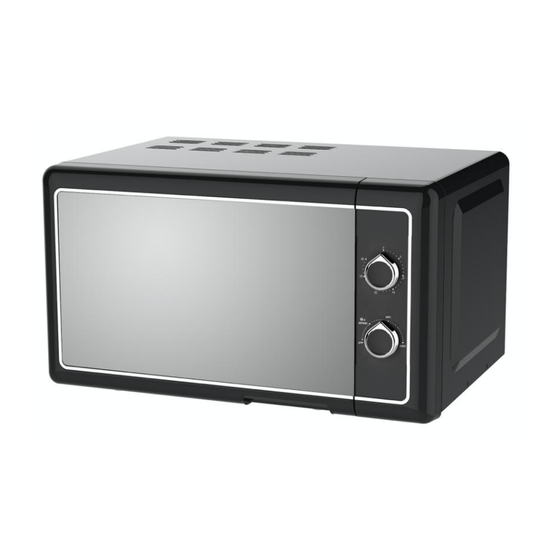
Advertisement
Quick Links
Advertisement

Summary of Contents for JDW Retro Style
- Page 1 JDW Retro Style Microwave Oven I/B Version 220V – 240V ~ 50Hz 171130 700W...
-
Page 2: Know Your Appliance
Know Your Appliance 1. Door safety locking system 2. Oven Window – Mirrored design 3. Oven Cavity 4. Glass Turntable 5. Turntable Hub 6. Turntable Roller Guide 7. Anti-Slip Feet 8. Rotary Timer Control Dial 9. Rotary Temperature Control Dial with Defrost Setting 10. -
Page 3: Important Safety Instructions
IMPORTANT SAFETY INSTRUCTIONS The safety instructions in your manual are important and should be read carefully. Keep your manual for future reference. MAINTENANCE: If your appliance is not maintained in a good condition, its surface could be damaged and diminish inexorably the lifespan of the appliance and lead to a dangerous situation. - Page 4 - leave at least 10 cm of free space on each side and above the appliance. 2. As a general rule, make sure there is enough ventilation in the room around this appliance during operation. Stand the appliance on a stable heat-resistant surface (not a varnished table or a table cloth).
- Page 5 10. Do not attempt to disassemble the appliance or to remove feet, seals, screws etc. 11. WARNING: Children should not use this appliance without supervision except if they were previously given proper instructions so that they can use it correctly and understand the risks linked to improper use.
- Page 6 16. Eggs in their shell or whole hard-boiled eggs must not be heated in the microwave oven as they might explode. 17. Microwave heating of beverage can result in delayed eruptive boiling, therefore care has to be taken when you handle the container.
- Page 7 The symbol is always put on the surface with the highest temperature, however the other metallic or non-metallic surfaces can also become very hot during use and it is therefore advisable to always handle them with care and if possible with the help of isothermal gloves or other thermal protection.
-
Page 8: Microwave Cooking Principles
UK STYLE PLUG WIRING INSTRUCTIONS (IN THE UK ONLY) This product must only be used from a 13 amp power socket. If a BS1363 approved 13 amp plug is used, it should be fitted with a 13 amp fuse conforming to BS1362 and be ASTA approved. - Page 9 The table below is a general guide to help you select the correct utensils for use within your Microwave Oven. Microwave Cookware Cooking Heat–Resistant Glass Non Heat–Resistant Glass Heat–Resistant Ceramics Microwave–Safe Plastic Dish Kitchen Paper Metal Tray Metal Rack Aluminium Foil &...
- Page 10 Interrupting the programme To turn or stir the food preparation, e.g. after half of the cooking time, it is often necessary to interrupt the programme. Open the door to interrupt the programme. The timer will pause. After you have closed the door, the timer will restart from the point that it stopped and will continue to run.
-
Page 11: Cleaning And Care
BEFORE YOU CALL FOR SERVICE If the microwave oven fails to operate: Check to ensure that the microwave oven is plugged in securely. If it is not, remove the plug from the outlet, wait 10 seconds and plug it in again securely. Check for a blown circuit fuse or a tripped main circuit breaker. - Page 12 PROTECTION OF THE ENVIRONMENT – DIRECTIVE 2012/19/EU In order to preserve our environment and protect human health, the waste electrical and electronic equipment should be disposed of in accordance with specific rules with the implication of both suppliers and users. For this reason, as indicated by the symbol on the rating label or on the packaging, your appliance should not be disposed of as unsorted municipal waste.
- Page 13 GUARANTEE This product is guaranteed against manufacturing defects for a period of 1 year. This does not cover the product where the fault is due to misuse, abuse, use in contravention of the instructions, or where the product has been the subject of unauthorised modifications or alterations, or has been the subject of commercial use.
Need help?
Do you have a question about the Retro Style and is the answer not in the manual?
Questions and answers